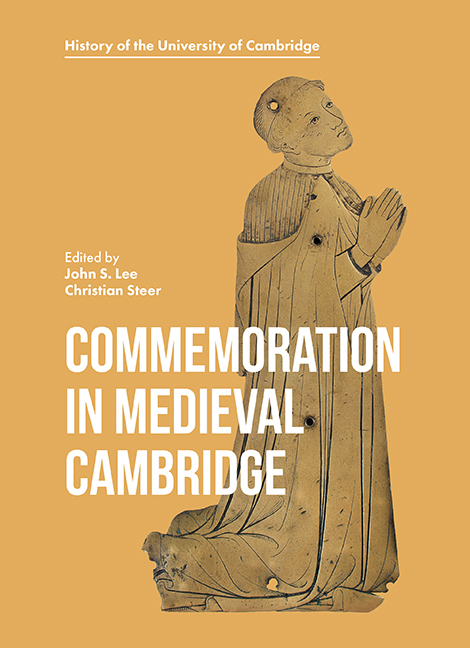Book contents
- Frontmatter
- Contents
- List of Illustrations
- Acknowledgements
- List of Contributors
- Abbreviations
- Introduction: In Fellowship with the Dead
- 1 Monuments and Memory: A University Town in Late Medieval England
- 2 The Commemoration of the Living and the Dead at the Friars Minor of Cambridge
- 3 The City of London and the Founding of the Guild of Corpus Christi
- 4 Patrons and Benefactors: The Masters of Trinity Hall in the Later Middle Ages
- 5 A Comparison of Academical and Legal Costume on Memorial Brasses
- 6 Commemoration at a Royal College
- 7 Cambridge Commemorations of Lady Margaret Beaufort's Household
- 8 ‘The Stones are all disrobed’: Reasons for the Presence and Absence of Monumental Brasses in Cambridge
- Bibliography
- Index
5 - A Comparison of Academical and Legal Costume on Memorial Brasses
Published online by Cambridge University Press: 25 October 2019
- Frontmatter
- Contents
- List of Illustrations
- Acknowledgements
- List of Contributors
- Abbreviations
- Introduction: In Fellowship with the Dead
- 1 Monuments and Memory: A University Town in Late Medieval England
- 2 The Commemoration of the Living and the Dead at the Friars Minor of Cambridge
- 3 The City of London and the Founding of the Guild of Corpus Christi
- 4 Patrons and Benefactors: The Masters of Trinity Hall in the Later Middle Ages
- 5 A Comparison of Academical and Legal Costume on Memorial Brasses
- 6 Commemoration at a Royal College
- 7 Cambridge Commemorations of Lady Margaret Beaufort's Household
- 8 ‘The Stones are all disrobed’: Reasons for the Presence and Absence of Monumental Brasses in Cambridge
- Bibliography
- Index
Summary
The history of English legal costume is now reasonably clear, and it might be supposed that the history of academical dress would be even clearer, but in fact that is far from being the case. There has been a great deal of confused antiquarianism, and the only book on the subject – by an author who also managed to confuse the history of legal dress almost beyond recovery – made things worse rather than better.
Written sources are not as helpful as might be supposed. The few medieval regulations which survive from Oxford and Cambridge used words well understood at the time but not defined or explained with helpful diagrams. The same is true of secondary sources such as wills and inventories. But the proposition to be made in this essay is that more can be learned from lateral investigations, by comparing brasses with paintings, monuments and written sources, by considering what happened to the various forms of dress as they evolved in later periods, and by drawing parallels with legal dress. Brasses are a plentiful source of illustration, but many academical figures are anonymous and therefore of limited use as evidence for the dress appropriate to particular degrees; allowance must also be made for a measure of artistic licence or ignorance which prevents us from relying on brasses in the same way that we might rely on photographs or paintings from the life. For the present exploratory purpose, the concentration will be on scarlet robes – the formal full dress of doctors of divinity and law, of judges of the benches,3 and of serjeants at law. There are examples of the later black undress gowns on brasses, but the black doctoral gown is not in obvious ways different from that worn by laymen in the Tudor period.
Doctors at Cambridge and Oxford now have two principal orders of dress, the festal gown of scarlet cloth faced with silk and the undress black gown. The scarlet hood is worn with either gown, on occasions when hoods are worn. Until the nineteenth century there was a third form of dress known at Cambridge as the congregation habit. This still survives at Oxford as the convocation habit, and a vestige lives on at Cambridge for a different purpose, which will be noticed later.
- Type
- Chapter
- Information
- Commemoration in Medieval Cambridge , pp. 90 - 105Publisher: Boydell & BrewerPrint publication year: 2018



